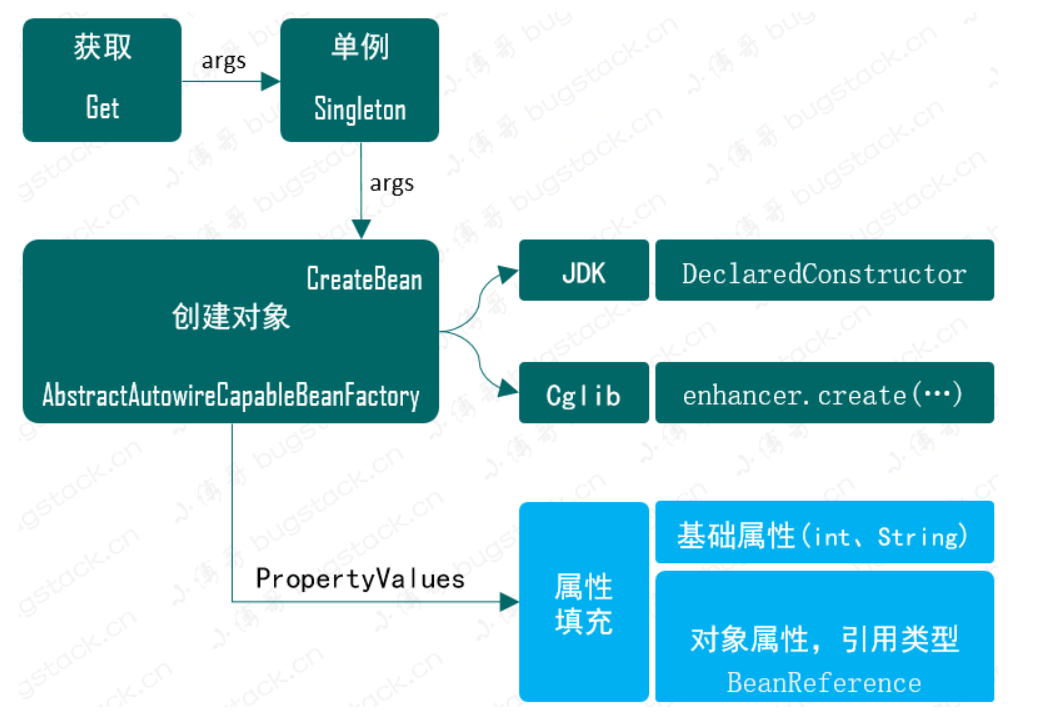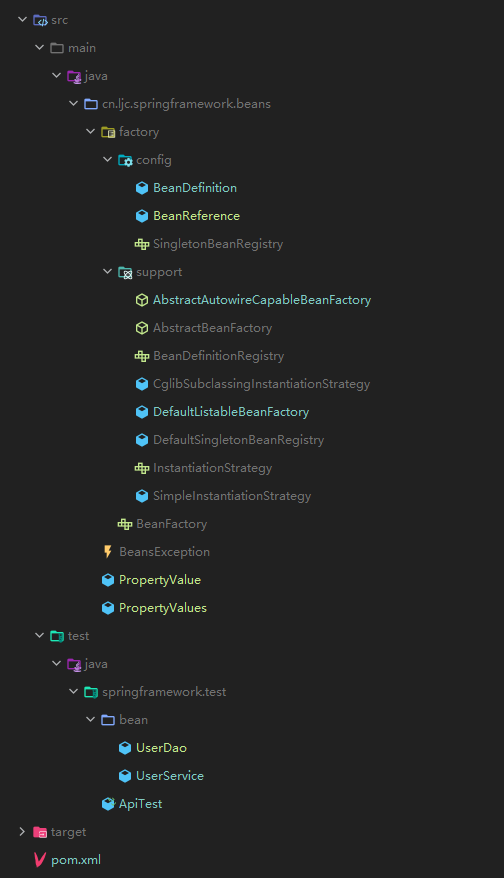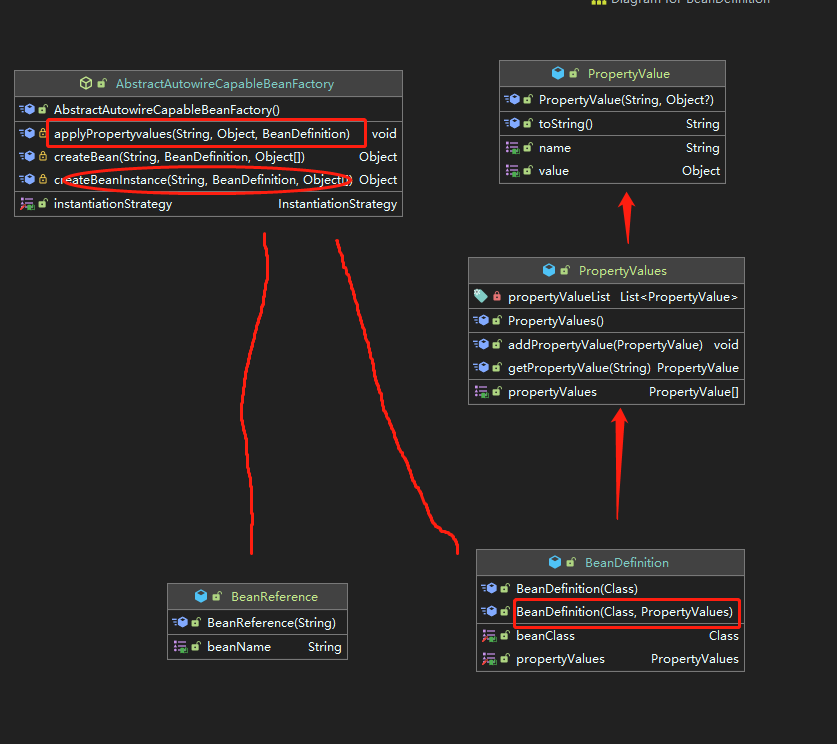目标
这一章节目的是接着前面的实例化策略实现后,进行属性填充,才算是真正的实例化结束
今天这里暂时不考虑循环依赖,后续会加上
设计思路

主要做了几件事情
1、属性填充是在创建实例化后,在AbstractAutowireCapableBeanFactory 的createBean方法中添加applyPropertyValues 操作。
2、由于我们需要在创建Bean时候填充属性操作,那么就需要在 bean 定义 BeanDefinition 类中,添加 PropertyValues 信息。
3、填充属性还包括的bean的对象类型,所以需要添加一个BeanReference(区分于普通属性类型,如果是bean对象则递归进行创建和填充)
项目结构

核心关系图

新增加3个类,BeanReference(类引用)、PropertyValue(属性值)、PropertyValues(属性集合),分别用于类和其他类型属性填充操作。
另外改动的类主要是 AbstractAutowireCapableBeanFactory,在 createBean 中补全属性填充部分
一、实现
1、定义属性
/**
* 属性
*/
public class PropertyValue {
private final String name;
private final Object value;
public PropertyValue(String name, @Nullable Object value) {
this.name = name;
this.value = value;
}
public String getName() {
return name;
}
public Object getValue() {
return value;
}
@Override
public String toString() {
return "PropertyValue{" +
"name='" + name + '\'' +
", value=" + value +
'}';
}
}
属性的包装类
2、定义属性集合包装类
/**
* 属性集合
*/
public class PropertyValues {
private final List<PropertyValue> propertyValueList = new ArrayList<>();
public void addPropertyValue(PropertyValue pv){
this.propertyValueList.add(pv);
}
public PropertyValue[] getPropertyValues(){
return this.propertyValueList.toArray(new PropertyValue[0]);
}
public PropertyValue getPropertyValue(String propertyName){
for (PropertyValue propertyValue : propertyValueList) {
if(propertyValue.getName().equals(propertyName)){
return propertyValue;
}
}
return null;
}
}
维护每个类下的属性集合
3、类引用(bean类型)
/**
* 类引用
*/
public class BeanReference {
private String beanName;
public String getBeanName() {
return beanName;
}
public BeanReference(String beanName) {
this.beanName = beanName;
}
}
在属性填充时,循环处理时,用于区分是一个bean类型还是一个普通类型,是bean类型则需要递归去创建和获取bean,普通属性则直接赋值
4、Bean定义补全
/**
* @desc Bean定义
* @Author: ljc
* @Date: 2022/11/28 10:35
*/
public class BeanDefinition {
private Class beanClass;
private PropertyValues propertyValues;
public BeanDefinition(Class beanClass) {
this.beanClass = beanClass;
this.propertyValues = new PropertyValues();
}
public BeanDefinition(Class beanClass,PropertyValues propertyValues) {
this.beanClass = beanClass;
this.propertyValues = propertyValues != null ? propertyValues : new PropertyValues();
}
public Class getBeanClass() {
return beanClass;
}
public void setBeanClass(Class beanClass) {
this.beanClass = beanClass;
}
public PropertyValues getPropertyValues() {
return propertyValues;
}
public void setPropertyValues(PropertyValues propertyValues) {
this.propertyValues = propertyValues;
}
}
新增了1个构造函数,方便初始化bean定义时,直接填充属性
5、Bean 属性填充
/**
* @desc 实例化Bean类
* @Author: ljc
* @Date: 2022/12/7 13:06
*/
public abstract class AbstractAutowireCapableBeanFactory extends AbstractBeanFactory{
private InstantiationStrategy instantiationStrategy = new CglibSubclassingInstantiationStrategy();
/**
* 创建bean
* @param beanName
* @param beanDefinition
* @param args
* @return
* @throws BeansException
*/
@Override
protected Object createBean(String beanName, BeanDefinition beanDefinition, Object[] args) throws BeansException {
Object bean = null;
try {
bean = createBeanInstance(beanName,beanDefinition,args);
// 属性填充
applyPropertyvalues(beanName,bean,beanDefinition);
} catch (Exception e) {
throw new BeansException("Instantiation of bean failed", e);
}
addSingleton(beanName,bean);
return bean;
}
/**
* 创建实例
* @param beanName
* @param beanDefinition
* @param args
* @return
*/
protected Object createBeanInstance(String beanName, BeanDefinition beanDefinition, Object[] args) {
Constructor constructorToUse = null;
Class beanClass = beanDefinition.getBeanClass();
Constructor[] declaredConstructors = beanClass.getDeclaredConstructors();
for (Constructor ctor : declaredConstructors) {
if (args != null && ctor.getParameterTypes().length == args.length) {
constructorToUse = ctor;
break;
}
}
return getInstantiationStrategy().instantiate(beanDefinition,beanName,constructorToUse,args);
}
/**
* 属性填充
* @param beanName
* @param bean
* @param beanDefinition
*/
protected void applyPropertyvalues(String beanName, Object bean,BeanDefinition beanDefinition) {
try {
PropertyValues propertyValues = beanDefinition.getPropertyValues();
for (PropertyValue propertyValue : propertyValues.getPropertyValues()) {
String name = propertyValue.getName();
Object value = propertyValue.getValue();
if (value instanceof BeanReference) {
// 获取 依赖的对象实例化
BeanReference beanReference = (BeanReference) value;
value = getBean(beanReference.getBeanName());
}
BeanUtil.setFieldValue(bean, name, value);
}
} catch (BeansException e) {
throw new BeansException("Error setting property values:" + beanName);
}
}
/**
* 获取实例化策略
* @return
*/
public InstantiationStrategy getInstantiationStrategy() {
return instantiationStrategy;
}
// 定义实例化策略
public void setInstantiationStrategy(InstantiationStrategy instantiationStrategy) {
this.instantiationStrategy = instantiationStrategy;
}
}
这个类的内容稍微有点长,主要包括三个方法:createBean、createBeanInstance、applyPropertyValues,这里我们主要关注 createBean 的方法中调用的 applyPropertyValues 方法。
1、在 applyPropertyValues 中,通过获取 beanDefinition.getPropertyValues() 循环进行属性填充操作,如果遇到的是 BeanReference,那么就需要递归获取 Bean 实例,调用 getBean 方法。
2、当把依赖的 Bean 对象创建完成后,会递归回现在属性填充中。这里需要注意我们并没有去处理循环依赖的问题,这部分内容较大,后续补充。
3、BeanUtil.setFieldValue(bean, name, value) 是 hutool-all 工具类中的方法,你也可以自己实现
二、测试
1、准备
public class UserDao {
private static Map<String, String> hashMap = new HashMap<>();
static {
hashMap.put("10001", "ljc");
hashMap.put("10002", "yaya");
hashMap.put("10003", "zz");
}
public String queryUserName(String uId) {
return hashMap.get(uId);
}
}
public class UserService {
private String uId;
private UserDao userDao;
public void queryUserInfo(){
System.out.println("查询用户信息:" + userDao.queryUserName(uId));
}
public String getuId() {
return uId;
}
public void setuId(String uId) {
this.uId = uId;
}
public UserDao getUserDao() {
return userDao;
}
public void setUserDao(UserDao userDao) {
this.userDao = userDao;
}
}
2、测试案例
public class ApiTest {
@Test
public void test_BeanFactory() {
// 1、初始化 BeanFactory
DefaultListableBeanFactory beanFactory = new DefaultListableBeanFactory();
// 2、userDao 注册bean定义
beanFactory.registerBeanDefinition("userDao",new BeanDefinition(UserDao.class));
// 3、userService设置属性
PropertyValues propertyValues = new PropertyValues();
propertyValues.addPropertyValue(new PropertyValue("uId","10002"));
propertyValues.addPropertyValue(new PropertyValue("userDao",new BeanReference("userDao")));
// 4 、userService注入bean
BeanDefinition beanDefinition = new BeanDefinition(UserService.class,propertyValues);
beanFactory.registerBeanDefinition("userService", beanDefinition);
// 5、获取 bean
UserService userService = (UserService) beanFactory.getBean("userService");
userService.queryUserInfo();
}
}
1、与直接获取 Bean 对象不同,这次我们还需要先把 userDao 注入到 Bean 容器中。
beanFactory.registerBeanDefinition("userDao", new BeanDefinition(UserDao.class));
2、接下来就是属性填充的操作了,一种是普通属性 new PropertyValue(“uId”, “10001”),另外一种是对象属性 new PropertyValue(“userDao”,new BeanReference(“userDao”))
3、接下来的操作就简单了,只不过是正常获取 userService 对象,调用方法即可。
3、测试结果
查询用户信息:yaya
Process finished with exit code 0























 407
407











 被折叠的 条评论
为什么被折叠?
被折叠的 条评论
为什么被折叠?










